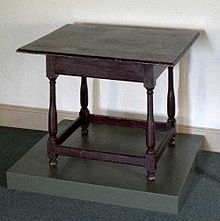The first
settlers of Germantown, PA are called the “Original 13.” They were commemorated by a special stamp on their 300th anniversary.
Notice the dwelling in the drawing above.
All three Op Den Graeff brothers' names are on this monument.
These first settlers were mostly Quakers, and
they were from a region on the lower Rhine where German and Dutch cultures
blended. William Penn had visited them in his effort to
colonize Pennsylvania. Pastorius, a
German, was Penn’s land agent and said that the place was named Germantown,
which means “Brother City of the Germans.”
We are related to three of the Original 13:
Derick, Herman, and Abraham Op Den Graeff.
They were brothers who sailed together on the ship “Concorde,”, with
their mother, Greitijen to the new colony, arriving in Philadelphia in October,
1683 after a 75-day journey. Greitijen
died shortly after arriving. We are directly related to
Abraham, the youngest of the three brothers.
Abraham’s daughter, Anneken, married Herman DeHaven (parents of the
rabble-rouser, Abraham DeHaven).
The first winter
in Germantown was very difficult. The
Original 13 had hoped to arrive earlier in the year, but had met many delays
with their passage. They did not have
time to erect cabins before winter set in, so they dug holes in the sides of
hills to live in. In the spring, they
built log cabins, then later, stone houses.
Abraham Op Den
Graeff and his brothers were weavers by trade, and helped establish the linen
trade in Germantown, which became known as the best in the world. Abraham won a prize given by the Governor for
the finest linen woven in the state of Pennsylvania. He was very active in the affairs of the
settlement, serving as town burgess (delegate).
He was also a member of the Provincial Assembly of Pennsylvania for
several years.
One of the most
interesting pieces of legislation that Abraham and three other Germantown
Quakers signed was the first formal protest against slavery. The document was “tabled” because it was so
controversial, but, almost 100 years later, Pennsylvania became the first state
to pass a law to gradually abolish slavery.
The table on which the Anti Slavery Petition was signed, available to view at the
Old Mennonite Meeting House in Germantown
In 1892, there
was a parting of ways in the Quaker community, with some reverting back to
Mennonite or Dutch Reformed teaching.
Abraham reverted back to the Mennonite roots of his family. His grandfather, Herman Op Den Graeff, was a
well-known Mennonite preacher and bishop in Krefeld, Germany. Herman was a very prosperous linen weaver, as
evidenced by the beautiful stained glass windows that were in his home. Two of the windows have been preserved in the
Kaiser-Wilhelm Museum in Berlin.








No comments:
Post a Comment